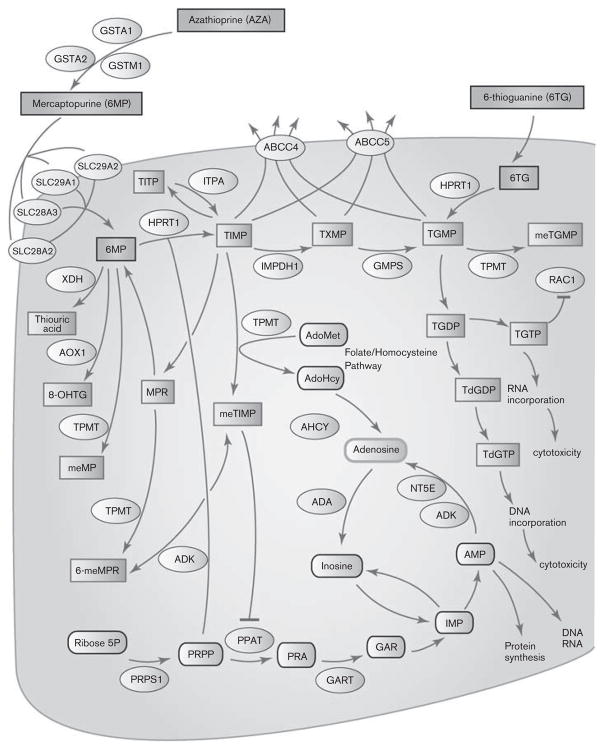The thiopurine drugs are purine antimetabolites widely used in the treatment of acute lymphoblastic leukemia, autoimmune disorders (e.g. Crohn’s disease and rheumatoid arthritis) and of organ transplant recipients. As inactive prodrugs, 6-mercaptopurine (6-MP), 6-thioguanine (6-TG) and azathioprine require intracellular activation, catalyzed by multiple enzymes, to exert cytotoxicity. The first step in azathioprine activation is the release of 6-MP, which involves glutathione transferases and nonenzy-matic conversion. Transport of 6-MP into the cell involves SLC28A2, SLC28A3, SLC29A1 and SLC29A2. After the uptake, 6-MP is converted into thioinosine mono-phosphate by hypoxanthine guanine phosphoribosyl transferase, with 5-phospho-D-ribose-1-pyrophosphate as the phosphoribosyl donor. In a similar way, 6-TG can be converted into thioguanosine monophosphate (TGMP). Thioinosine monophosphate can be converted into TGMP in two steps: first, thioxanthosine monophosphate is formed by inositol monophosphate dehydrogenase; second, TGMP is formed by guanosine monophosphate synthetase. Subsequently, TGMP can be converted into TG nucleotide diphosphates and triphosphates. Cyto-toxic effects of thiopurine drugs are achieved through incorporation of thio-deoxyguanosine triphosphate into DNA and of thioguanosine triphosphate into RNA, by inhibition of de novo purine synthesis by methylmercap-topurine nucleotides and by inhibition of Rac1 (this inhibition induces apoptosis in activated T-cells). The thio-deoxyguanosine triphosphate incorporation inhibits the function of several enzymes involved in DNA replication and repair, and induces DNA damage such as single strand-breaks, DNA–protein cross-links and chromatid exchanges. The pathway that leads to synthesis of active metabolites is in competition with inactivation pathways catalyzed by xanthine oxidase or the polymorphic thiopurine methyltransferase (Fig. 1 - see following page).
Fig. 1.
Thiopurine pathway (PharmGKB PA2040: http://www.pharmgkb.org/do/serve?objId=PA2040&objCls=Pathway). ABCC4, multidrug resistance-associated protein 4; ABCC5, multidrug resistance-associated protein 5; ADA, adenosine deaminase; ADK, adenosine kinase; AdoHcy, S-adenosylhomocysteine; AdoMet, S-adenosyl-methionine; AHCY, S-adenosylhomocysteine hydrolase; AOX1, aldehyde oxidase 1; GAR, glycinamide ribotide; GART, phosphoribosylglycinamide formyltransferase; GMPS, guanosine monophosphate synthetase; GSTA1, glutathione-S-transferase A1; GSTA2, glutathione-S-transferase A2; GSTM1, glutathione-S-transferase M1; HPRT1, hypoxanthine guanine phosphoribosyltransferase 1; IMPDH1, inosine monophosphate dehydrogenase type 1; ITPA, inosine triphosphatase pyrophosphatase; MeMP, methylmercaptopurine; 6-meMPR, 6-methylmercaptopurine riboside; MeTGMP, methyl-thioguanosine monophosphate; MeTIMP, methyl-thioinosine monophosphate; MPR, 6-mercaptopurine riboside; NT5E, nucleotidase, ecto-5-prime; 8-OHTG, 8-hydroxythioguanine; PPAT, phosphoribosyl pyrophosphate amidotransferase; PRA, 5-phosphoribosylamine; PRPP, 5-phospho-D-ribose-1-pyrophosphate; PRPS1, phosphoribosyl pyrophosphate synthetase 1; RAC1, ras-related C3 botulinum toxin substrate 1; SLC28A2, solute carrier family 28, member 2; SLC28A3, solute carrier family 28, member 3; SLC29A1, solute carrier family 29, member 1; SLC29A2, solute carrier family 29, member 2; TdGDP, 6-thio-deoxy-guanosine diphosphate; TdGTP, 6-thio-deoxy-guanosine triphosphate; TGDP, 6-thio-guanosine diphosphate; TGMP, thioguanosine monophosphate; TGTP, 6-thio-guanosine triphosphate; TIMP, thioinosine monophosphate; TITP, thioinosine triphosphate; TPMT, thiopurine S-methyltransferase; TXMP, thioxanthosine monophosphate; XDH, xanthine dehydrogenase.
Acknowledgments
PharmGKB is supported by the NIH/NIGMS Pharmacogenetics Research Network (PGRN; UO1GM61374).



